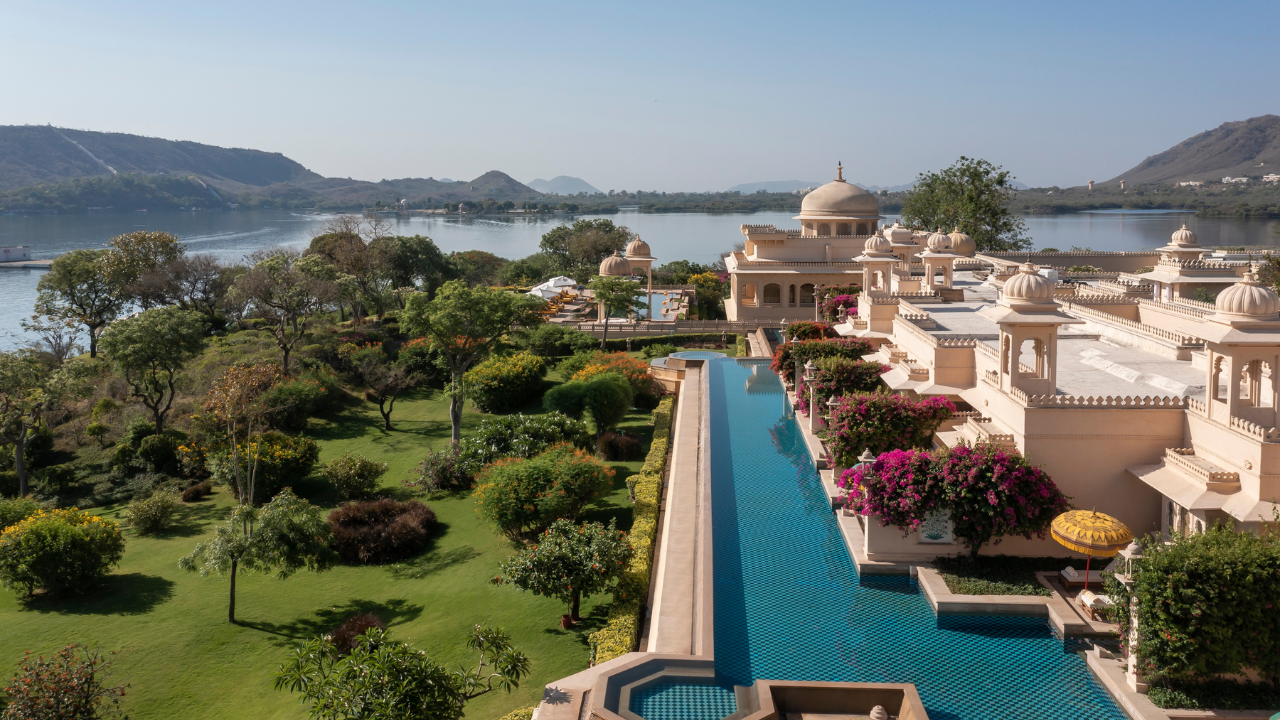Brand Stories
Oberoi to Stay Rooted in India while Branching out Overseas, ETBrandEquity

The Oberoi Group is primed for further growth as its eponymous brand sits right at the “centre” of premium travel—the fastest-growing segment in India’s hospitality industry, Arjun Oberoi, executive chairman of the luxury hotel chain told ET. He said the group will enter new markets like Saudi Arabia and Egypt while continuing its sharp focus on the growing domestic market.
Also, speaking in a joint interview, Vikram Oberoi, group CEO, said over the last few years, the operator of Oberoi and Trident brand of hotels has seen a “strong” uptick in financial performance. This was fuelled by a clear mandate of growing the hotel portfolio with “carefully-curated, brand-aligned” properties, driving a high premium strategy, outperforming rivals during periods of high demand, and offering “exceptional” service to guests, he said.
It was the first media interaction of the two Oberoi scions since the passing away of patriarch PRS Oberoi in November 2023 and the formal handing over of the baton to the third generation of the Oberoi family.
Results of the transition efforts are bearing fruit, with the Oberoi Group delivering one of the strongest financial performances in its 90-year history in FY25. For the year ended March 2025, EIH Ltd, the group’s flagship company, posted a 14% rise in net profit at Rs 770 crore, while revenue grew 10% at Rs 2,880 crore.
Vikram Oberoi said as guests turn more selective in their choices of hotels, they are willing to pay a premium for the level of service offered by the chain.
“People are traveling more, both for leisure and business. When reviewing STR (Smith Travel Research) data for our hotels, we find that we have significantly outperformed the market on revenue per available room, with a premium on both average room rates and occupancy levels,” he said. “In almost all locations, Oberoi is ranked first on revenue per available room in its competitive set.”
Going forward, Oberoi predicts the pace of affluence in India to accelerate faster than ever before. “Twenty years ago, the number of Indian-to-foreign guest ratio was small. The proportion of our Indian guests has grown exponentially.”
Having signed 21 new projects in less than two years, the chain has embarked on its most ambitious growth strategy. The pipeline portfolio includes 19 hotels, two luxury boats, and a Nile River cruiser. A dozen of these new properties are in India with the rest across London, Saudi Arabia, Egypt, Bhutan, and Nepal. A total of 16 properties will operate under the Oberoi brand, and five under Trident.
About half of the new portfolio will be owned and the rest run under management contracts. Last November, The Oberoi Group said it will open a hotel in London’s Mayfair through an arrangement between British urban property major Grosvenor and EIH London Investments Ltd. South Molton, in London’s Mayfair, will be home to the chain’s first Oberoi Hotel in the UK.
Saudi Arabia is another big focus, said Arjun Oberoi.
“We’ve already announced two hotels there. We’re also entering countries where, frankly, we should’ve been earlier. Indonesia is one. Egypt is another. And of course, India will remain our main thrust. That’s where the global economy is turning its attention, and it’s still the right time to invest here,” he said.
While both Indian and overseas chains seem to be aggressively expanding in India, Arjun Oberoi emphasised that the chain is competing against its own set benchmarks and standards, and that it doesn’t want to stretch its brands beyond a point where it risks dilution.
“Why are our hotels recognised around the world? It’s not just because we’ve chosen beautiful destinations—it’s because we’ve crafted each hotel with love, with care, with thoughtfulness,” he said.
“We need to set internal targets— they should reflect broader industry trends—but in many ways, the real benchmark is ourselves. That’s the race we’re running, not against others, but against our own standards.” The chain opened one hotel earlier this year, The Oberoi Vindhyavilas in Bandhavgarh, with the Oberoi Rajgarh Palace set to open in October. “We are also launching cruises on the Nile. In all that we do, we must always meet and exceed the expectations of our guests,” said Arjun Oberoi.
While comparisons are drawn between price points of popular Indian and short-haul international getaways during the peak season, CEO Vikram Oberoi said the Indian luxury market is “actually underpriced for the value it delivers.”
On incoming foreign tourist arrival numbers lagging pre-pandemic levels, he said it is not just up to the government to promote India, but the private sector also has a role to play.
“Having more ambassadors promoting India is good for our future and will help grow tourism, business investment and job creation. We want international visitors to return home and say, ‘What an amazing country, what wonderful people.’ This goodwill brings more international visitors — whether for business or for leisure,” he said.
“Opportunities lie with the private sector partnering with the government to market India. With this shared mission, the whole nation benefits,” he added.
Technology is also playing a quiet but decisive role in EIH. “We have already implemented Generative AI at Oberoi and we are expanding it to select Trident hotels,” he said. “A lot of our back-office processes are now powered by AI. There’s no manual intervention for many of the repetitive tasks.”
Residences is also a focus area for the chain, especially wherever there is a hotel and a viable residential opportunity, said Arjun Oberoi. “Mixed-use developments are increasingly becoming the preferred model, and many of our potential partners approach us saying this is the best way to monetise their assets,” he said.
He noted that “there is strong demand for branded residences, so it’s something we’re committed to alongside hotels being a part of a mixed-use development.”
Rai Bahadur Mohan Singh Oberoi, TRS Oberoi and P.R.S. Oberoi’s vision shaped the group’s legacy. The latter formed a large part of the conversation.
“We have been left with a very strong foundation—we don’t really need to change the formula too much. And I believe this is India’s time. We’re well placed to propel the brand and drive our expansion during this period of growth,” said Arjun Oberoi.
The chain continues to get about half of its guests from countries around the world, with a quarter from the US alone. In less than two years, the chain signed 21 hotels, but the guests are still at the heart of everything the chain does, noted Vikram Oberoi.
“That’s our DNA built by our founder chairman and our chairman Emeritus. I still remember—as children, Arjun and I would see Rai Bahadur, going through every guest comment. That attention to detail and the passion for our guests is at the core of our organisation and our 90-year history,” he said. “That is what has made our hotels special for our guests and why they select us and are willing to pay a premium to stay at our hotels. We need to preserve this, reinforce it, and support it at every level.”
Brand Stories
Artificial intelligence can power Xizang’s leap into a better future – Opinion

When you stand at 4,000 meters above the sea level, the future looks closer. For the Xizang autonomous region, artificial intelligence is not a novelty to be imported and placed on a shelf but a practical instrument to improve people’s livelihoods, safeguard a fragile ecology and accelerate high-quality development. Xizang’s abundant green energy, unique climate and strategic position linking China with South Asia give it a rare opportunity to convert natural endowment into digital advantage while retaining its culture, ecology and security.
Three key measures could take Xizang in this direction: deepening AI adoption in culture and tourism, fusion of AI with Xizang’s healthcare and Tibetan medicine, and building a green computing power hub that anchors high-tech industry, skills and jobs. The guiding principle must be innovation with Xizang characteristics, firmly aligned with national strategies and local custodianship.
Culture and tourism are strategic pillars of Xizang and a people-centered industry that shapes livelihoods. AI offers tools to strengthen every link in this value chain through rigorous digital collection of artifacts and sites, intelligent processing and curation and scenario-based presentations that provide genuinely immersive experiences.
For Xizang, its work is cut out: It needs to combine AI-generated content with augmented, virtual and mixed reality to produce multilingual, authoritative narratives that are accessible without being trivial, and design a digital cultural and tourism experience park that combines the Potala Palace, Namtso and other landmarks into one coherent and correctly interpreted journey. Such a platform would serve diverse domestic and international visitors, expand services and let Xizang culture travel beyond the plateau even as it remains rooted in local custodianship.
This is not merely a spectacle for spectacle’s sake. It is a creative transformation that respects authenticity, broadens participation and creates new livelihoods in content production and intelligent operations.
High-plateau health and Tibetan medicine are emerging industries essential to the well-being of residents and visitors and to Xizang’s high-quality growth. AI should not replace traditional knowledge; it should sharpen and scale it.
These practical steps can work in this direction: Developing wearable smart devices tailored to plateau physiology that can predict health risks and enable timely intervention for residents, workers and tourists; applying AI and knowledge-graph technologies to organize Xizang medical knowledge, uncovering promising diagnostic pathways, and identifying active ingredients in traditional formulations; and promoting genuine medical-engineering collaboration so that Tibetan medicine and modern healthcare can reinforce each other.
The outcome would be a distinctive, data-informed service system that drives measurable development and progress.
Xizang’s mix of hydro, solar and wind power, together with its cool, dry conditions, favors energy-efficient data-center operations. The region’s location as a gateway to South Asia also offers diplomatic and economic complementarities under the Belt and Road Initiative. These advantages make a persuasive case for a green computing power center that plugs into China’s integrated computing network and meets demand from the eastern and central regions.
Around that anchor, a green computing power industrial park could attract AI, big data and biopharmaceutical firms, catalyzing spillovers into culture and tourism, characteristic farming and Tibetan medicine. The park must be paired with ambitious talent program: joint training with inland universities, hands-on practice bases and a deliberate push to grow a local, high-level technical workforce. That “computing power-industry-talent” cycle will reduce reliance on traditional extractive models and accelerate a transition to a technology-driven economy.
Exporting clean computing services also deepens practical cooperation with neighboring countries and helps build a shared digital future.
AI will be judged by how it tackles hard problems in hard places. Intelligent simulation, ecological early warning and coordinated optimization can reduce risks and improve outcomes for major projects such as the Sichuan-Xizang Railway. And advance modeling helps in saving costs and safeguarding the environment.
Equally important, green computing enables real-time processing of satellite remote-sensing data to monitor grassland degradation, glacier retreat, wetland change and forest fires. This would strengthen decision-making for the Qinghai-Tibet Plateau where ecological protection and development are complementary goals. Developing large-scale AI models across ecology, remote sensing, climate, tourism, highland health and governance would clear the current “no computing power” bottlenecks in border areas and enable genuine leapfrog development.
Sections of the Sichuan-Xizang Railway corridor, where the Hengduan Mountains offer low temperatures and stable geology, are well suited to host a national-level data disaster-recovery center powered by green energy. Built to national standards, such a facility would strengthen China’s informatization drive, catalyze Xizang’s information industry and contribute to balanced regional development.
The underlying principle of these proposals is that innovation must be people-centered with ecology and security at its core. By placing Xizang culture at the heart of digital experiences, tailoring technology to the plateau’s health needs, and anchoring computing power in green energy and local talent, Xizang can convert resource endowment into knowledge intensity and isolated potential into shared prosperity.
At the roof of the world, the margin for error is small. That is precisely why a careful central government-guided innovation that is grounded in local realities and national strategy offers Xizang a realistic path to a more prosperous, resilient and culturally vibrant future.
The author is an academician of the Chinese Academy of Engineering, a professor at Tibet University and director of the State Key Laboratory of Tibetan Intelligence. The views don’t necessarily represent those of China Daily.
If you have a specific expertise, or would like to share your thought about our stories, then send us your writings at opinion@chinadaily.com.cn, and comment@chinadaily.com.cn.
Brand Stories
The Race for AGI Poses New Risks to an Unstable World

In the headlong rush for technological supremacy, strange new risks are being created. Just as nuclear scientists were unsure whether the first atomic blast would ignite the earth’s atmosphere, today’s AI researchers can’t say whether smarter-than-human computers would be friends or foes. There’s a chance, some believe, that superhuman intelligence might escape human control entirely. If a runaway AGI wanted to harvest our oxygen, electricity, and carbon for its own purposes, there might be nothing we could do to stop it. In this way, some scientists fear, the winner of the race to AGI might be neither the U.S. nor China, but rogue AI itself, spelling the end of human civilization.
The Trump Administration is skeptical of these risks. The bigger danger, current and former White House insiders say, is of the U.S. losing its technological lead to China. It is this belief, more than any other, that is defining the U.S. government’s approach to AI. “It should be unacceptable to any American to live in a world in which China could outcompete us in AI, and reap the economic and military benefits,” David Sacks, President Trump’s AI czar, said in January. “If we hobble ourselves with unnecessary regulations,” he added a month later, “[China] is going to take advantage of that fact, and they’re going to win.”
Brand Stories
West Virginia College Partners With Industry to Create AI Program

Students in rural West Virginia will gain access to emerging AI skills thanks to a newly funded, fully online Applied Artificial Intelligence certificate program at Eastern West Virginia Community and Technical College (Eastern WVCTC). The program received $169,000 from a state grant to build career-focused AI instruction supported by tech giant IBM and aerospace manufacturer Northrop Grumman, according to a news release last week.
The college is teaming up with these private-sector partners to design curriculum for an AI-enabled workforce. Under the grant, Eastern will hire a specialist to develop a one-year certificate program training students on machine learning, data analysis and AI applications, Robert Burns, director of nonprofits and grant management at Eastern, wrote in an email to Government Technology. From there, the program will expand to include an Associate of Applied Science in AI. Both IBM and Northrop Grumman will help define competencies most needed by employers and may also offer apprenticeships or staff support.
Burns said the new certificate builds on the college’s existing efforts, like their cyber intelligence degree program and a one-day prompt engineering course held in June. Free to residents of neighboring counties, the school offered 45-minute sessions introducing ChatGPT and providing demos.
“Following our successful one-day seminar on AI prompt development, we recognized a genuine and growing community need for structured training in AI skill sets,” Burns wrote in an email. “In addition, our technology partners, IBM and Northrop Grumman, confirmed a direct need for workers with applied AI skills.”
What Burns noticed is not unique to West Virginia. Nearly 57 million white-collar workers in America are interested in gaining AI skills, and only 15 percent of them are currently enrolled in structured learning programs to do so, according to a report last month from higher-ed research firm Validated Insights.
The same report found that demand for credential-bearing AI programs is growing quickly. From 2016 to 2023, completions of AI degrees and certificates grew by almost 10 times.
Looking forward, Eastern WVCTC hopes to continue its AI work with stand-alone AI modules oriented toward workforce development. Burns said the courses would be stackable and count toward the AI certificate and degree programs, serving shorter-term upskilling and longer-term academic interests alike.
-

 Brand Stories1 month ago
Brand Stories1 month agoBloom Hotels: A Modern Vision of Hospitality Redefining Travel
-

 Brand Stories1 month ago
Brand Stories1 month agoCheQin.ai sets a new standard for hotel booking with its AI capabilities: empowering travellers to bargain, choose the best, and book with clarity.
-

 Destinations & Things To Do1 month ago
Destinations & Things To Do1 month agoThis Hidden Beach in India Glows at Night-But Only in One Secret Season
-

 Destinations & Things To Do1 month ago
Destinations & Things To Do1 month agoUntouched Destinations: Stunning Hidden Gems You Must Visit
-

 AI in Travel1 month ago
AI in Travel1 month agoAI Travel Revolution: Must-Have Guide to the Best Experience
-

 Family Travel2 months ago
Family Travel2 months agoThings to Do Indoors in New Jersey
-

 Brand Stories2 months ago
Brand Stories2 months agoVoice AI Startup ElevenLabs Plans to Add Hubs Around the World
-

 Brand Stories1 month ago
Brand Stories1 month agoContactless Hospitality: Why Remote Management Technology Is Key to Seamless Guest Experiences
-

 Restaurants & Food5 months ago
Restaurants & Food5 months ago10 New Restaurants In Delhi NCR To Head To This Month
-

 Brand Stories2 months ago
Brand Stories2 months agoHow Elon Musk’s rogue Grok chatbot became a cautionary AI tale













